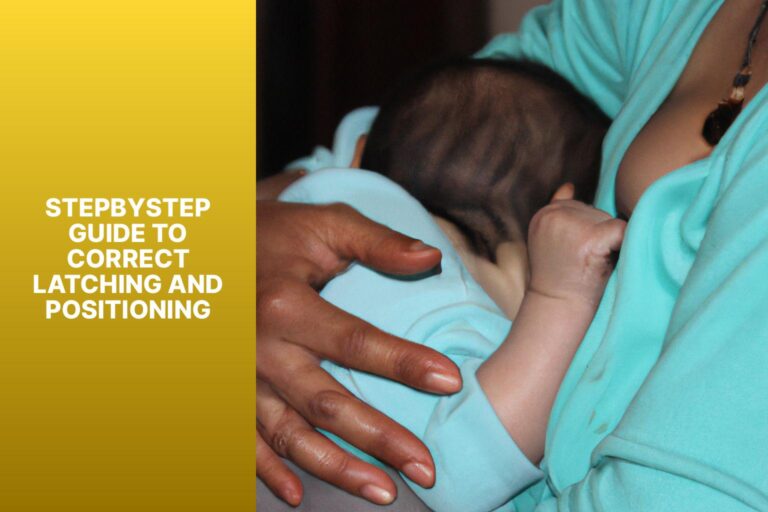Guidelines for Successful Breastfeeding After C Section
Embarking on your breastfeeding journey after surgery, specifically a cesarean birth, can be an experience filled with mixed emotions and unique challenges. Yet, it remains an essential part of bonding with your newborn and providing the unparalleled benefits of your own milk. As you recover from this major surgery, know that successful breastfeeding is not only possible but can be an empowering and healing process for both you and your baby.
Whether your cesarean section was planned or unexpected, lactation after c section begins with understanding the value of skin-to-skin contact and its profound influence on nursing after c section. Hospitals aligned with the Baby-Friendly Hospital Initiative (BFHI) provide supportive environments that promote exclusive breastfeeding post-cesarean. They recognize the importance of fostering an immediate and uninterrupted physical connection between you and your baby. This practice encourages a smoother start to breastfeeding despite the surgical context.
Your determination to provide the best for your baby through exclusive breastfeeding post-cesarean will be bolstered by support systems and healthcare partners committed to your breastfeeding journey after surgery. Together, you can navigate this vital path with knowledge and assurance, aimed at achieving successful breastfeeding after c section.
Skip To The Following Sections
- Preparing for Breastfeeding in a C-Section Context
- Optimizing Postpartum Recovery and Lactation
- Embracing New Breastfeeding Norms Post-Cesarean
- FAQ
- How can I successfully breastfeed after a cesarean section?
- What should I consider when choosing a hospital for my c-section to support breastfeeding?
- Why is skin-to-skin contact important after a cesarean delivery?
- What are the benefits of rooming-in after a cesarean section?
- How can I manage pain during postpartum recovery while breastfeeding after a c-section?
- What breastfeeding positions are best after a cesarean section to avoid discomfort?
- Can I breastfeed my baby if separated due to c-section complications?
- How can I overcome breastfeeding difficulties after a cesarean?
- Are there any special considerations for lactation after c-section?
- How do Baby-Friendly Hospitals promote successful breastfeeding post-cesarean?
Key Takeaways
- Breastfeeding after cesarean is key for bonding and nourishing your newborn.
- Choose a BFHI hospital to support your exclusive breastfeeding goals.
- Immediate skin-to-skin contact post-surgery can greatly enhance successful nursing.
- Access to lactation support can ease the transition into breastfeeding after c section.
- Recovery support and pain management are crucial to maintain lactation after c section.
- Frequent and early breastfeeding encourages milk production and feeding success.
- Your perseverance and proactive planning can ensure a rewarding breastfeeding journey after surgery.
Preparing for Breastfeeding in a C-Section Context
As you anticipate the arrival of your newborn, selecting a healthcare facility that upholds Baby-Friendly Hospitals standards can be an influential decision. These facilities are recognized by their evidence-based breastfeeding policies and are instrumental in promoting breastfeeding after a c section. It is crucial to engage with a supportive hospital environment for breastfeeding since it provides specific breastfeeding support for c section moms.
Choosing a Supportive Hospital Environment
Facilities awarded the Baby-Friendly designation are dedicated to the success of nursing after cesarean section. These hospitals prioritize practices such as delaying routine newborn procedures to ensure you and your baby have crucial early contact. A table below outlines the features you might expect:
| Feature | Benefit to Breastfeeding After C-Section |
|---|---|
| Immediate Skin-to-Skin Contact | Promotes instinctive nursing and mother-infant bonding |
| Rooming-In Policy | Enhances the ability to recognize and respond to baby’s feeding cues |
| Staff Trained in Breastfeeding Support | Provides guidance and assistance in establishing breastfeeding, especially in modified positions for c-section recovery |
| Deference of Routine Newborn Procedures | Focuses on the importance of the first breastfeeding session without interruptions |
The Significance of Skin-to-Skin Contact Post-Surgery
Immediate skin-to-skin contact between you and your newborn can significantly ease the breastfeeding initiation post-c section. The undisturbed warmth and tactile connection are crucial for your baby’s transition to the external world and encouraging their natural reflexes to breastfeed.
“Immediate and uninterrupted skin-to-skin contact is a game-changer for initiating breastfeeding after a cesarean delivery. It not only calms your baby but also facilitates natural breastfeeding behaviors to take root.”
Understanding Rooming-In Benefits for You and Your Baby
The concept of rooming-in post c-section birthing experience is now a norm in many hospitals. This practice allows you to stay attuned to your baby’s needs, thereby reducing breastfeeding challenges after a c section. Such proximity has been linked to numerous other rooming-in benefits as noted in the list below:
- Fosters a stronger bond between mother and baby through continuous interaction.
- Facilitates learning and responsiveness to the baby’s hunger cues.
- Reduces stress for both the mother and baby, creating a peaceful environment conducive to healing.
- Supports a higher rate of exclusive breastfeeding.
In addition to these strategies, familiarizing yourself with different breastfeeding positions for c section moms is helpful to ensure comfort during nursing sessions. Embrace the skin-to-skin cesarean recovery approach as it enhances the wellness of both you and your child and streamlines the initiation of breastfeeding.
Optimizing Postpartum Recovery and Lactation

Approaching postpartum recovery breastfeeding after a cesarean can seem daunting, but with the right strategies and support, overcoming breastfeeding difficulties post-cesarean is entirely possible. A key component of this is optimizing lactation through effective pain management and by embracing a nurturing environment that promotes exclusive breastfeeding post-c section.
For many mothers, pain management breastfeeding holds great importance as discomfort from the incision may impact the ability to nurse comfortably. It’s reassuring to know that most medications used during and after a c-section, such as regional anesthetics, only minimally enter the bloodstream and have negligible effects on the baby. Hence, they support the dual goals of pain relief and safe breastfeeding.
“By adequately managing post-cesarean pain, you’re not only looking after your comfort but also safeguarding your newborn’s well-being and your mutually beneficial breastfeeding routine.”
Pain medication can help reduce discomfort and enable mothers to focus on their newborn. Effective relief positions you to be more responsive to your baby’s needs and can facilitate a deeper connection during nursing sessions. It’s important to discuss options with your healthcare provider to ensure medications are compatible with lactation.
Adapting Breastfeeding Positions
Adapting breastfeeding positions helps resolve worries about latch-on difficulties and provides comfort to the mother. Whether it’s using the football hold or lying on your side, discovering positions that don’t put pressure on your incision site is key to overcoming breastfeeding difficulties post-cesarean.
Your recovery room should be a sanctuary where you are supported by knowledgeable staff—nurses and lactation consultants can introduce you to modified holds and techniques suitable for your situation. Access to these resources in the hospital is invaluable, fostering your confidence as you learn to nurse after surgery.
| Position | Description | Benefits |
|---|---|---|
| Football Hold | Holding the baby at your side, with their feet pointing towards your back | Relieves pressure on the abdomen; Ideal for mothers with large breasts or small babies |
| Side-Lying Position | Both mother and baby lie on their sides, facing each other | Eases the strain on the incision and allows for rest while breastfeeding |
| Upright Hold | Baby is held vertically against the mother’s body | Suitable for mothers with a strong let-down or babies with reflux |
Once comfortably positioned, frequent nursing is encouraged to stimulate milk production and fortify the bond with your newborn. If separation from your baby occurs, it’s essential to use a breast pump every two to three hours to maintain supply and encourage full lactation.
Emotional Support and Breastfeeding Success
The journey toward exclusive breastfeeding post-c section isn’t solely about the physical aspects. Emotional recovery plays a profound role in overcoming breastfeeding difficulties post cesarean. It is okay to experience an array of emotions post-delivery, and articulating these feelings is not only healthy but can bring closure and peace, which indirectly contribute to breastfeeding success.
During this time, lean on your support network—whether it be a partner, family members, or friends—so that you can put your energy into nursing and bonding with your baby. Remember that as you care for your newborn, self-care is of equal importance for both your physical and emotional well-being.
By respectful pain management, adapting positions for comfort, and welcoming emotional support, you ensure a smoother transition into motherhood and breastfeeding. This trifecta is pivotal in optimizing lactation and enhancing postpartum recovery, helping you find not just success, but also joy in the precious early days with your baby.
Embracing New Breastfeeding Norms Post-Cesarean
As you conclude your cesarean birth journey and transition into the profound experience of nursing, remember that embracing breastfeeding after a c section is a path paved with new norms. The potential challenges of breastfeeding after a c section are there to be met with the wealth of resources and support systems at your disposal. By establishing breastfeeding positions for c section recovery, such as the football hold or side-lying position, you are proactively ensuring comfort and easing the process for both you and your baby.
The successful breastfeeding journey post-cesarean begins with recognizing the benefits that this special bond confers upon you and your child. Through frequent and intentional skin-to-skin contact, you not only aid the natural initiation of breastfeeding but also nurture the emotional well-being vital in the early postpartum period. Such steps substantiate the new norms in breastfeeding, demonstrating adaptability and resilience in the face of recovery and potential setbacks.
Your commitment to this process, fortified by the encompassing support of healthcare professionals and loved ones, represents the heart of your breastfeeding story. Each small victory on this journey echoes the sentiment that while the context may differ, the essence of breastfeeding as a nurturing, health-promoting practice remains constant. Take pride in each feed, for you are contributing to a narrative of successful breastfeeding post-cesarean, characterized by dedication, innovation, and most importantly, the love you pour into every ounce.
FAQ
How can I successfully breastfeed after a cesarean section?
Success in breastfeeding after a cesarean section includes immediate skin-to-skin contact when possible, rooming-in, understanding the best breastfeeding positions to avoid discomfort at the incision site, and seeking support from healthcare professionals, such as lactation consultants, while in the hospital.
What should I consider when choosing a hospital for my c-section to support breastfeeding?
You should look for hospitals that promote breastfeeding after c-section, such as those designated as Baby-Friendly Hospitals™ which support evidence-based breastfeeding policies, including skin-to-skin contact immediately after birth and providing rooming-in facilities.
Why is skin-to-skin contact important after a cesarean delivery?
Skin-to-skin contact immediately after surgery can facilitate instinctive breastfeeding behavior, strengthen the emotional bond between you and your baby, regulate the baby’s body temperature, and increase the likelihood of successful breastfeeding initiation.
What are the benefits of rooming-in after a cesarean section?
Rooming-in allows mothers to pick up on hunger cues and patterns, encourage more frequent breastfeeding which promotes milk production, and potentially reduces the risks of common breastfeeding issues. It also allows for closer monitoring of the baby’s health and well-being.
How can I manage pain during postpartum recovery while breastfeeding after a c-section?
Discuss pain management options with your healthcare provider preoperatively. Most pain relief medications compatible with breastfeeding post-cesarean are safe, and regional analgesia (such as an epidural) is often preferred as it results in minimal sedation of the newborn.
What breastfeeding positions are best after a cesarean section to avoid discomfort?
Breastfeeding positions such as the football hold, side-lying position, or using a breastfeeding pillow can help keep pressure off your incision site. Work with a lactation consultant to find the most comfortable position for you and your baby.
Can I breastfeed my baby if separated due to c-section complications?
Yes, you can express milk using a breast pump to maintain milk supply until you can establish direct breastfeeding. Hospital staff can assist you in providing the expressed milk to your baby until you are reunited.
How can I overcome breastfeeding difficulties after a cesarean?
Persistence, support, and patience are key. Utilize the help of healthcare providers, seek advice from lactation consultants, join support groups, and remember that overcoming difficulties can take time and may require different strategies.
Are there any special considerations for lactation after c-section?
After a cesarean, it may take a bit longer for your milk to come in due to stress and hormonal changes. Keep breastfeeding or pumping frequently to encourage milk production, stay hydrated, and ensure proper pain management to facilitate the nursing process.
How do Baby-Friendly Hospitals promote successful breastfeeding post-cesarean?
Baby-Friendly Hospitals prioritize immediate and continuous skin-to-skin contact, support breastfeeding initiation within the first hour of birth, provide rooming-in options, limit interventions during the postpartum stay, and ensure access to breastfeeding resources and support.










